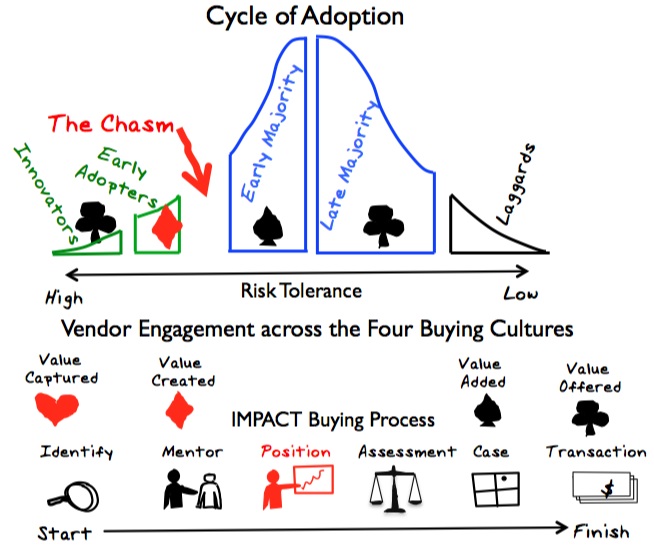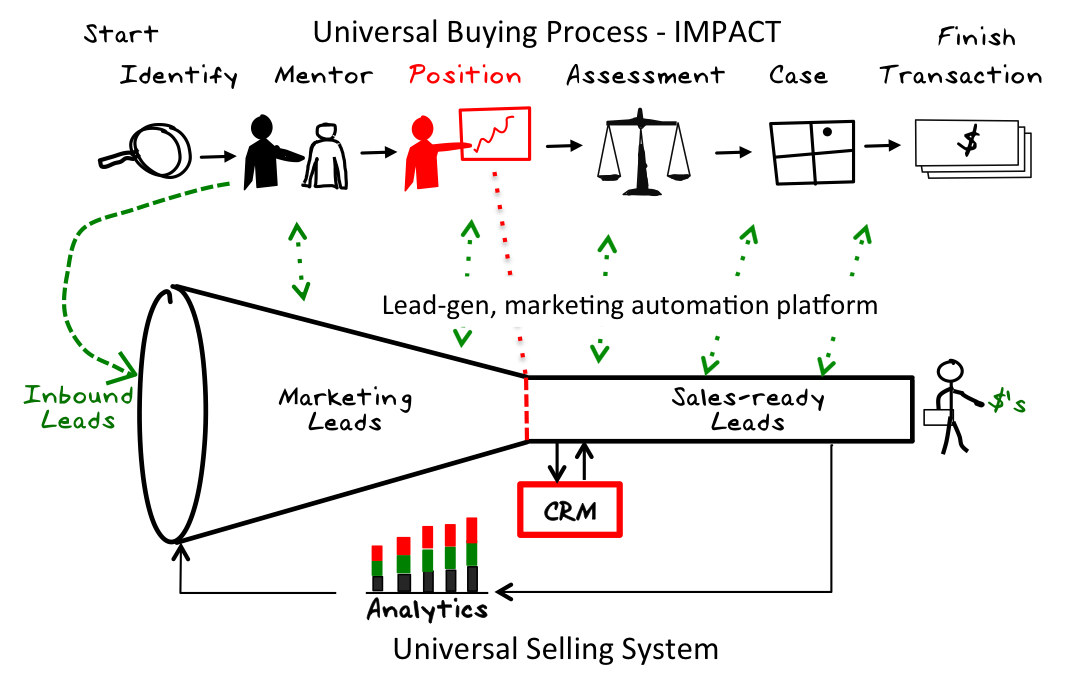Have you ever had a situation where you engaged a prospective lead, they showed a lot of interest, your meaningful conversations led to a demo or a presentation and then the prospective buyer went radio silent and disappeared?
This happens a lot; according to Scott Santucci of Forrester, at least 80% of the time leads fail to make it through the sales process. There are many possible reasons why leads die, but I suggest that most early leads don’t make it past the critical internal “fight for funds” (Positioning) phase in the buy cycle.
Buying behavior has changed permanently and way faster than most sellers and marketers have been able to adapt their processes and their business. Much recent debate about the point at which salespeople are engaged in the buying process leads me to believe that an in depth review of buying-selling process is required.
The Book that Launched a Thousand Others
“The Diffusion of Innovation,” by Everett Rogers is a hugely influential study on the process by which innovations are adopted or diffused into a population. This work, now in its fifth edition was first published in 1962 and has spawned dozens of books like “Crossing the Chasm,” by Geoffrey Moore, “The Tipping Point,” by Malcolm Gladwell and many others.
This series of article will help you understand why most early stage opportunities die, how buyers buy and how you can better influence a buying cycle in your favor. The articles are based on a collaboration with Dominic Rowsell, co-author of “Why Killer Products Don’t Sell” and adds a layer of understanding from the buyers perspective on how they go about buying innovative or disruptive technology and how risk affects vendor engagement.
Understanding the buying process will help sellers to engage and optimize their value chain. This is new thinking for most sales teams and with insights gained from this work, we can adjust our selling process to serve our customers according to how they buy – which is governed by their tolerance for risk.
Why do People Buy?
People buy for many and varied reasons; our role as sales professionals is to find out the underlying motives of the buyer and once in possession of this knowledge, do our best to satisfy the buyers needs.
People buy technology solutions and consulting services for dozens of reasons, however most of these can be distilled into the following four business drivers, or buyers compass.
- To grow top-line revenue
- To reduce cost and improve profit
- To create competitive advantage to attack new opportunities
- To reduce risk exposure to the business
How do People Buy?
There is a pathway or process that all organizations and individuals follow to reach purchasing decisions. This pathway is universal and does not vary by culture or geography as it is inextricably linked to human nature. What changes from one company to another is the speed at which organizations or individuals travel through the process.
Every purchase goes through the IMPACT cycle, either formally or informally, – with or without the supplier.
Whether an airline is buying a fleet of Boeing Dreamliners, a small business is buying an innovative new software service, or a family is buying a new laptop computer for the home, every purchase goes through the same process. For a Boeing 787 it may take 20 people two years to decide, for a Laptop in the home, it might take a discussion with your partner, a visit to a few Websites and a couple of hours in total.
The six steps in the buying process use an acronym which is easy to remember as it has huge I-M-P-A-C-T on organizational performance. Every purchase goes through all six phases, with or without the supplier.
Engagement and the Cycle of Adoption
The Cycle of Adoption shown in the visual confection below, layers the cycle of adoption over the universal buying process IMPACT and introduces the four buying behaviors and the point during the cycle of adoption that they engage buyers.

- Early adopters looking to get a jump on the competition will engage vendors very early in the buying process, when it’s still an idea and not yet an opportunity in a Value-Created buying culture. Early adopters represent 13% of the market. Many technologies never make it across the chasm into the mainstream adoption.
- Early majority buyers of mainstream technology products and software, i.e., where there is an established buying category and a handful of key players, will likely engage vendors at between 50-70% of the way through the buying cycle. This Value Added buying culture occurs when the customer recognizes they need to find a solution to a pain or opportunity and they are looking for options.
- Risk-averse mainstream buyers are conservative and will engage vendors when they are ready to buy the brand and model they want. The Value Offered buyer is looking for price, delivery and support. In an anomaly, the Value-Offered buying culture also exists in the “toy-shops” of major corporations where funds are allocated to experiment with new technology. This is typically show-up and throw-up sale made by founders showing off their shiny new thing. There is no guarantee that the innovation will find its way out of the lab into production.
- Joint ventures are an example of a Value Captured buying culture where the buyer and vendor partner from the outset to capture value and they share risks and rewards.
Buying Process and Vendor Alignment
Successful companies view sales and marketing as one continuous system that maps onto the customer buying process, where the sale begins in marketing by publishing keyword rich, SEO optimized thought leadership content to capture buyer interest at the ideation phase and some time later, through a continuous engagement process may result in a sale.
The Position step in IMPACT buying process is highlighted in red and marks the transition in the traditional selling system from a marketing lead to a sales ready lead. Position is the point at which most leads die. A marketing lead is not an opportunity and should not be in a sales forecast until the buyer has moved the opportunity beyond Position.
In the next article, I will discuss in depth what’s going on in the buying organization at each step in IMPACT, the role for marketing, sales, the risks and how we can manage them.




